Information Technology Reference
In-Depth Information
created due to the recognition of an element. They
explain which rules will have to be activated on
an element drawn there. Its syntax is:
possible so as to limit the rupture in the creative
process. Thus, in the presented rules and figures,
the gestures are the same as the classical ones.
We would like to highlight the possibility, with
this system, to model different ways to draw the
same symbol. This implies that it is possible, if
necessary, to use new alphabets such as the ones
presented in previous section and in Table 1.
DCC: R
1
[position
1
, part
1
]A
1
m_1
, … , R
n
[position
n
,
part
n
]A
n
m_n
This means that at the relative position
posi-
tion
i
of an element
R
i
, the part
part
i
of an element
A
i
can exist. The current element, in process of
creation, is referenced as “
this”
. The number
m_i
indicates how many
A
i
can exist in this context
and is
*
if there is no limit.
For example, the creation of a sharp on the
left of a note head does not imply the possibility
to draw a specific symbol. On the contrary, the
creation of a note head allows drawing one ac-
cidental on its left, one durational dot on its right
and one stem, either uprising or descending; then,
document structural contexts modelling where
these symbols can now exist are created and will
help in interpreting them. A DCC block for such
a rule can be written as:
a stroke analyzer
The second component of the system is a hand-
drawn stroke analyzer that eagerly interprets the
drawings of the user thanks to the knowledge
modelled by the formalism. In this section, we
first explain how we deal with multistroke sym-
bols. Then, we present the analysis process more
in detail, and finally highlight the exploitation of
the human-computer interaction.
An Incremental Interpretation Process
to Deal with Multi-Stroke Symbols
The system we propose interprets the user strokes
dynamically and incrementally. This means that
the analysis is applied every time the user draws
a stroke, like in unistroke symbol systems. If no
interpretation is found for a hand-drawn stroke,
it is rejected. On the contrary, if it can be inter-
preted, that is, if such a stroke can exist in such a
context, it is replaced by its neatly retranscribed
corresponding symbol and the system tries to
associate it with other elements of the document
in order to constitute multistroke symbols. Thus,
the dynamic segmentation process is deduced
from the formalism. For instance, the
Sharp
interpretation rule presented in Table 2 models
that where a sharp can exist, two horizontal and
two vertical segments can also exist; but once
they do, they can be replaced by a sharp if their
shape is coherent. This analysis process is close
to the one proposed by Miyao et al. (2004) and
Mitobe et al. (2004).
DCC: this[left, all]Accidental1,
Stem
structural
context
Durational dot
structural
context
Stem
structural
context
this[right, all]Dot1,
(this[rightUprising,all]Stem1 |
Accidental
structural
context
this[leftDescending all]Stem1).
We would like to emphasize that the acciden-
tal document structural context created in this
DCC block corresponds to the one exploited by
the DCV block of the sharp interpretation rule
defined previously and to note that disjunction
between contexts is possible. Finally, an alias
is defined to specify that an
Accidental
can be a
Flat
, a
Sharp
or a
Natural
.
The complete
QuarterNote
and
Sharp
inter-
pretation rules are given in Table 2.
As presented in previous section, our goal is
to design a pen-based musical score composition
software as close as possible to classical notations,
in order to be as user-friendly and as usable as


Search WWH ::

Custom Search